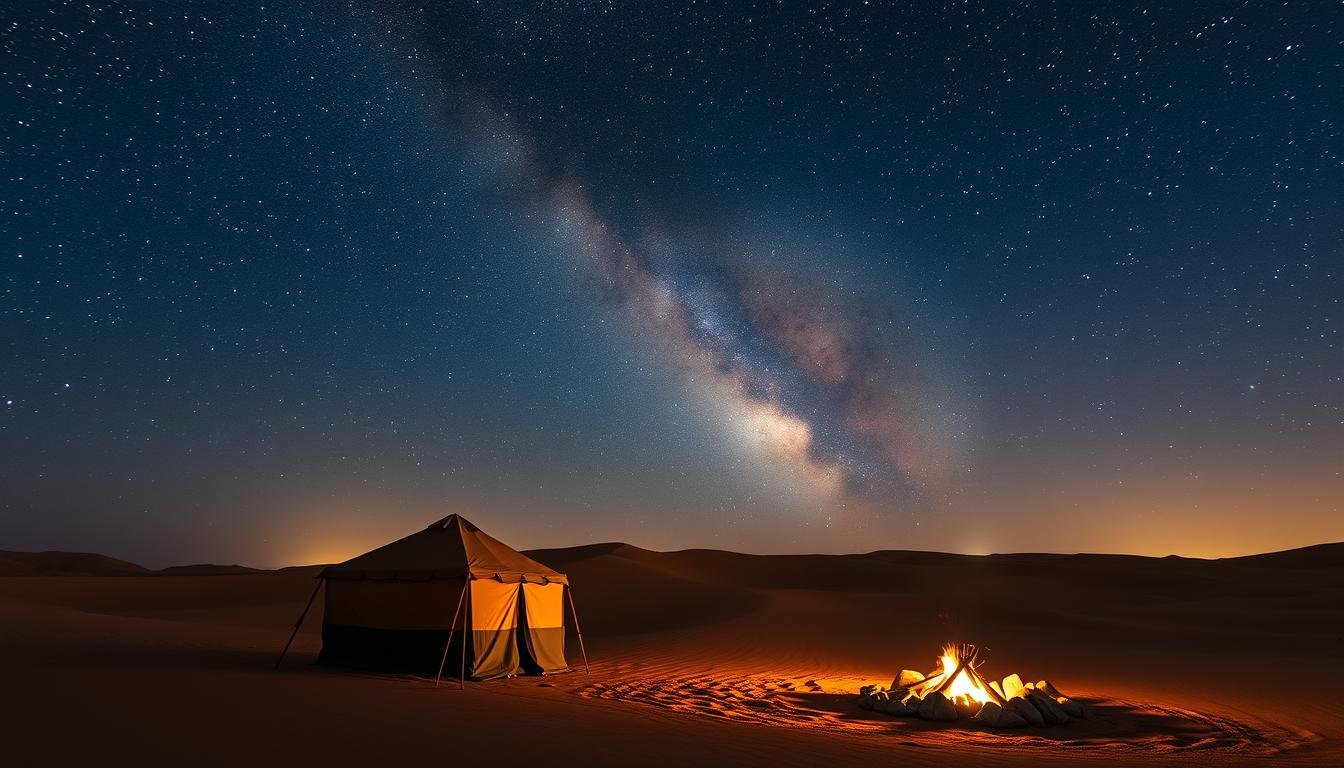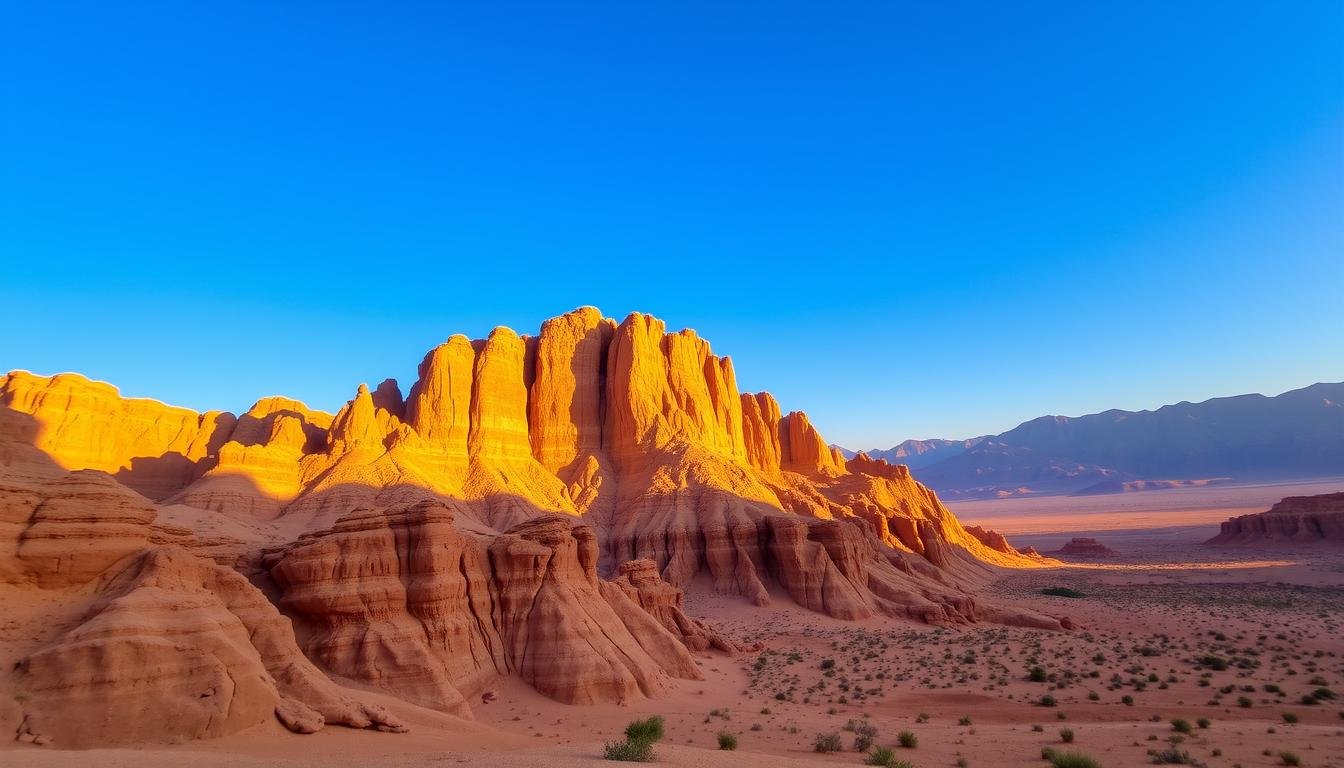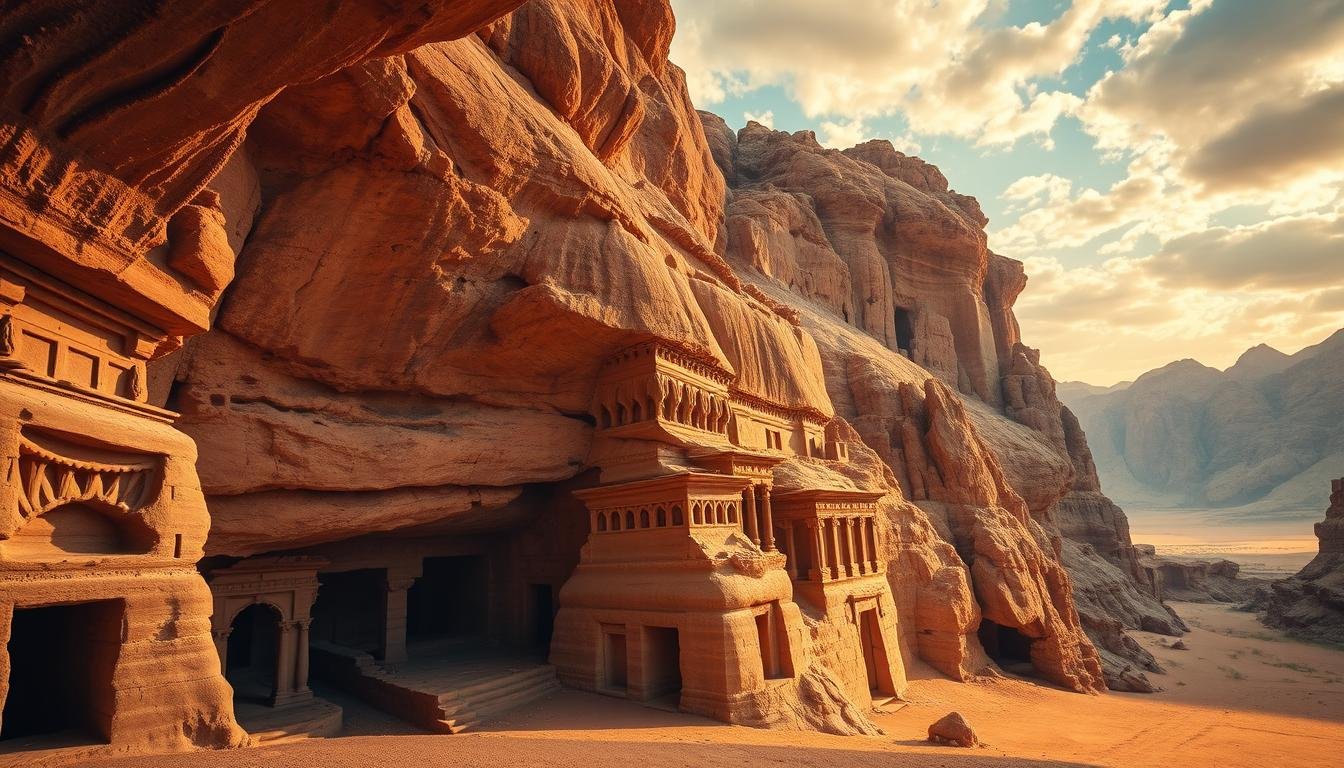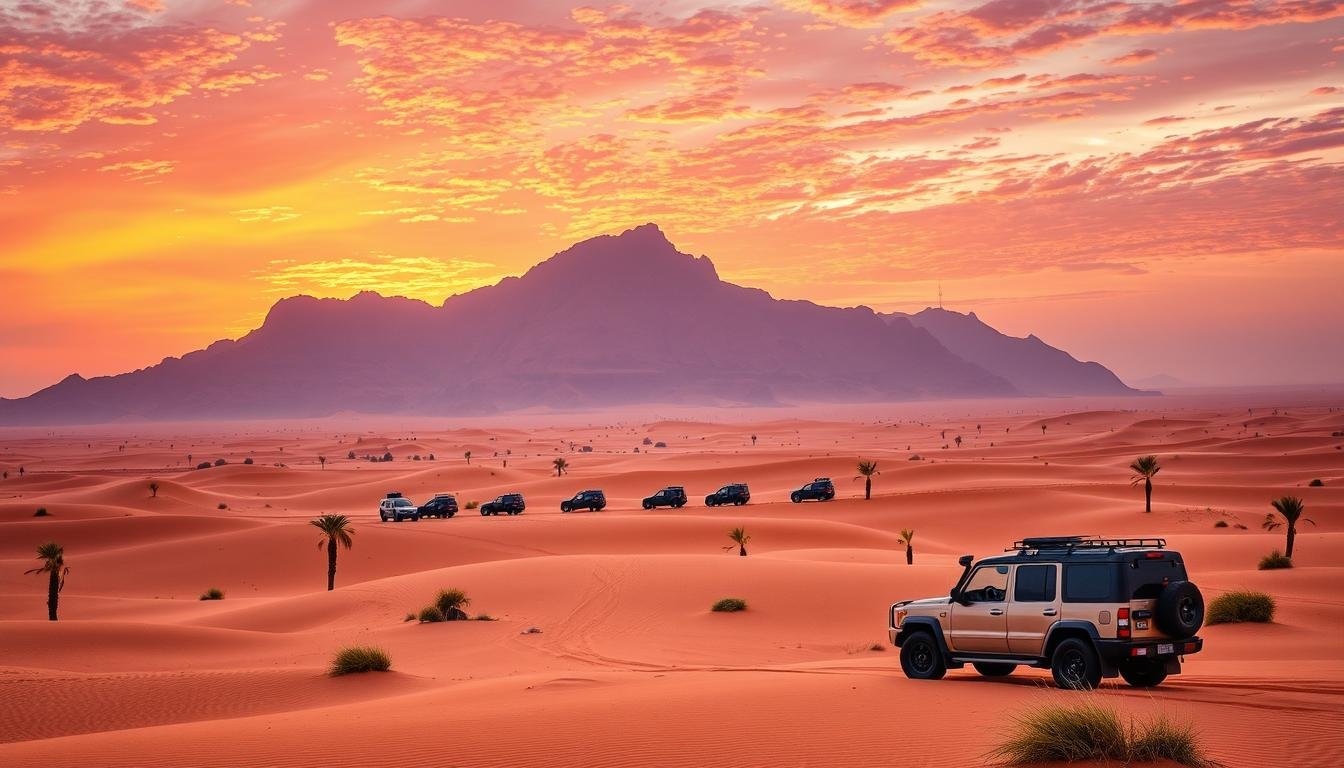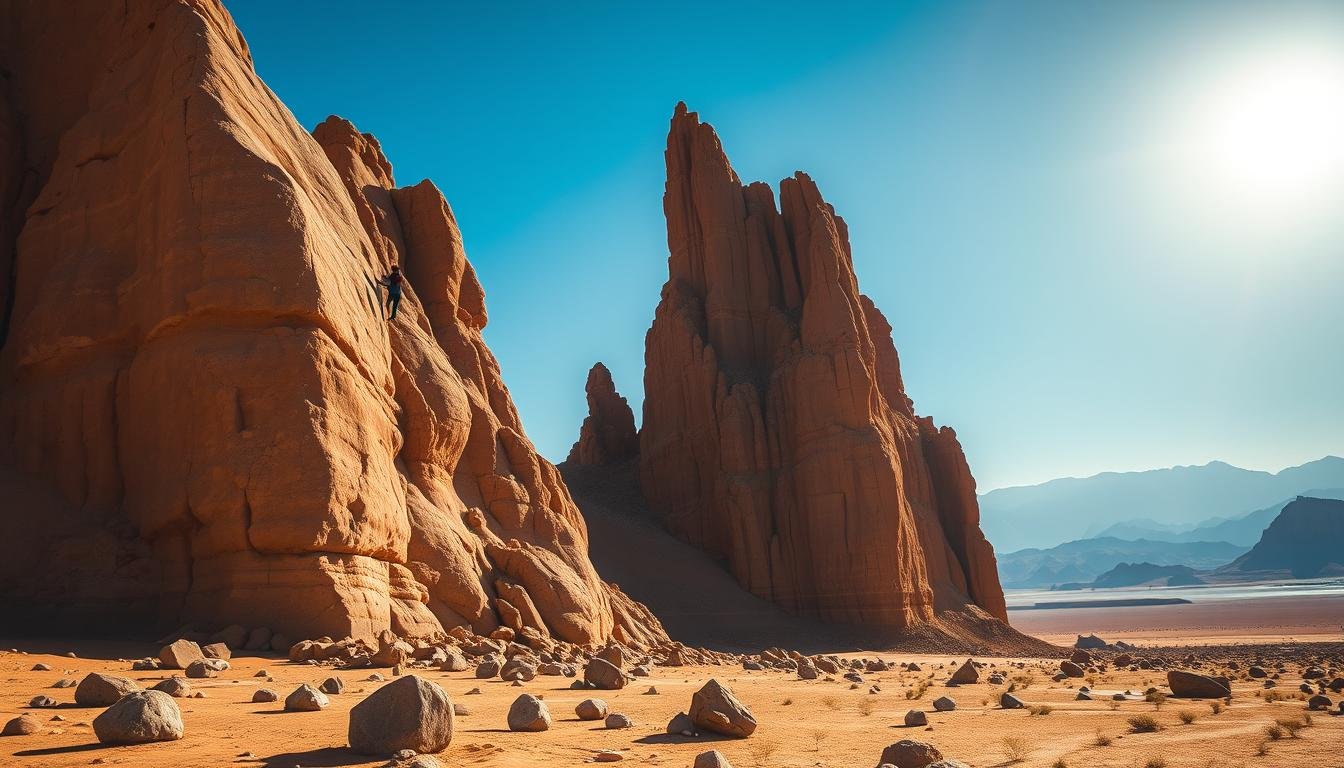Ever thought about seeing the stars from the desert? Saudi Arabia’s vast, untouched lands offer a unique stargazing experience. Get ready for a journey through the kingdom’s clear desert skies and discover how to enjoy astronomy.
The night sky in Saudi Arabia is filled with the Milky Way and vibrant constellations. But where do you start? This guide will give you the knowledge and tips you need for a great desert stargazing adventure. It’s perfect for both seasoned astronomers and curious beginners.
Your Guide to Stargazing in Saudi Arabia’s Pristine Desert Skies
Dive into the world of night sky viewing in Saudi Arabia’s vast deserts. This guide shows you the beauty of these clear skies. It invites you to start an amazing journey under the stars.
The deserts of Saudi Arabia are perfect for stargazers. There’s no light pollution and wide, empty lands. You can see the Milky Way and meteor showers in Saudi Arabia’s skies.
There are special dark sky areas in Saudi Arabia. Places like the Empty Quarter and Al Wadj Bank Dark Sky Reserve are kept dark. They offer great views of the stars and planets.
| Stargazing Destination | Key Features |
|---|---|
| Empty Quarter (Rub’ al Khali) | Largest sand desert in the world, vast and remote landscapes, exceptional dark sky conditions |
| Al Wadj Bank Dark Sky Reserve | Designated dark sky reserve, pristine desert environment, diverse celestial observations |
| Al-Ahsa Oasis Region | Lush oasis surrounded by desert, stunning night sky views, cultural and historical significance |
Whether you’re an expert or just curious, Saudi Arabia’s skies are unforgettable. Experience the peace of these vast lands. Let the stars above amaze you in this special place.
Best Times for Desert Stargazing in Saudi Arabia
Stargazing in Saudi Arabia’s vast deserts is a unique experience. To enjoy it fully, knowing the best seasons, monthly events, and weather is key. These factors greatly affect what you can see in the night sky.
Seasonal Viewing Conditions
The deserts of Saudi Arabia are great for stargazing all year. Winter offers clear skies for seeing stars and deep objects. Spring and fall have mild weather and fewer storms, perfect for astronomy fans.
Summer nights are warm, but sometimes cloudy. Still, it’s worth watching the night sky for amazing views.
Monthly Celestial Events Calendar
- January: Quadrantid meteor shower
- March: Vernal equinox, Comet Viewing
- April: Lyrids meteor shower
- May: Eta Aquariids meteor shower
- August: Perseids meteor shower
- October: Draconids and Orionids meteor showers
- November: Taurids and Leonids meteor showers
- December: Geminids and Ursids meteor showers
Optimal Weather Patterns
The desert climate in Saudi Arabia is ideal for astronomy. It has clear skies, low humidity, and little light pollution. The driest weather is from December to February, offering the best views.
Autumn and spring are also great for stargazing. They have mild temperatures and clear skies, perfect for seeing the night sky.
Essential Equipment for Desert Astronomy
Exploring the Saudi Arabian deserts for stargazing needs special gear. Whether you love astronomy or just enjoy looking at the stars, the right tools enhance your experience. They help you see the wonders of the desert sky.
Telescopes and Binoculars
A good telescope is key for desert sky adventures. Choose one with a big aperture to see faint stars clearly. Binoculars are also great for a closer look at the stars, planets, and galaxies.
Star Charts and Guides
Using star charts and guides makes navigating the night sky easy. They help you spot constellations, planets, and more. These tools are essential for a great desert stargazing trip.
Astrophotography Gear
If you want to capture the desert sky’s beauty, you need astrophotography gear. This includes a tripod, DSLR camera, and special lenses for low light. With the right equipment, you can take amazing photos of the Saudi Arabian skies.
It’s important to protect your gear from the desert’s harsh conditions. Use weatherproof cases and covers to keep your equipment safe from sand, wind, and temperature changes. With the right tools, you can fully enjoy desert stargazing and take photos to remember forever.
| Essential Equipment | Recommended Specifications |
|---|---|
| Telescope | Aperture of 4 inches or more, equatorial or Alt-Az mount |
| Binoculars | Objective lens diameter of at least 50mm, with high-quality optics |
| Star Charts | Detailed maps of the night sky, covering the visible constellations and celestial objects |
| DSLR Camera | Full-frame sensor, high-ISO performance, and interchangeable lenses |
| Tripod | Sturdy and stable, with the ability to handle the weight of your camera and lens |
Top Stargazing Locations in Saudi Arabian Deserts
Saudi Arabia’s vast deserts are perfect for stargazing. You can see the Milky Way in the Empty Quarter or the dark skies of Al Wadj Bank Dark Sky Reserve. These places offer amazing views of the stars.
Empty Quarter (Rub’ al Khali)
The Empty Quarter is huge, covering parts of Saudi Arabia, the UAE, Oman, and Yemen. It’s the biggest sand desert on Earth. The sky is very dark here, making it great for seeing stars and the Milky Way.
Al Wadj Bank Dark Sky Reserve
Al Wadj Bank in northwestern Saudi Arabia is a Dark Sky Reserve. It has very little light pollution. This makes it perfect for seeing the stars and planets in the sky.
Al-Ahsa Oasis Region
The Al-Ahsa Oasis is in the Eastern Province of Saudi Arabia. It’s a UNESCO World Heritage Site known for its greenery and springs. The clear skies here are great for stargazing, showing off planets and constellations.
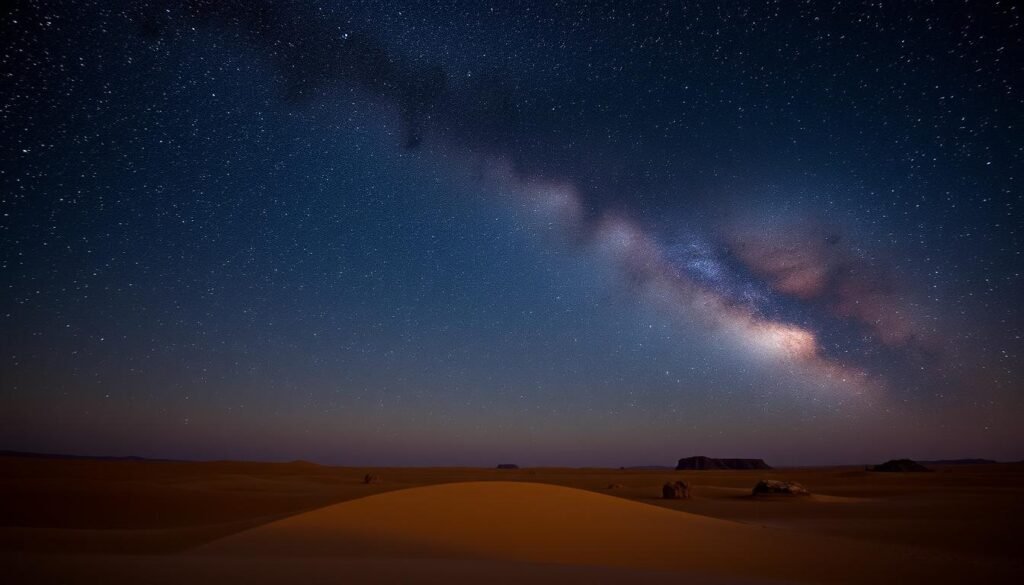
| Stargazing Location | Unique Features | Accessibility |
|---|---|---|
| Empty Quarter (Rub’ al Khali) | Largest continuous sand desert, exceptionally dark skies | Remote, accessible by 4×4 vehicles |
| Al Wadj Bank Dark Sky Reserve | Designated Dark Sky Reserve, protected night skies | Accessible by car, with designated stargazing areas |
| Al-Ahsa Oasis Region | UNESCO World Heritage Site, unique oasis landscape | Easily accessible, located near populated areas |
Understanding Saudi Arabia’s Dark Sky Preservation
Saudi Arabia is working hard to keep its desert skies dark and clear. They see the value of dark skies for astronomy, tourism, and protecting the environment. They have started many projects to keep the night sky beautiful for everyone to enjoy.
The Al Wadj Bank Dark Sky Reserve is a key part of this effort. It’s in the northwest of the country and is officially recognized as an International Dark Sky Reserve. This means it has strict rules to keep the sky dark, so people can see the stars better.
- The Al Wadj Bank Dark Sky Reserve is recognized as an International Dark Sky Reserve, one of the few such designations in the Middle East.
- Saudi Arabia has implemented comprehensive policies and regulations to curb light pollution and preserve the natural nighttime environment across the country.
- The kingdom’s commitment to dark sky preservation has made it an increasingly popular destination for astrotourism, attracting stargazers and astronomy enthusiasts from around the world.
Saudi Arabia is also protecting other areas from light pollution. This helps both stargazers and the local wildlife. It shows their dedication to keeping the desert night sky safe and beautiful.
Saudi Arabia is becoming a major center for astronomy and tourism. Their focus on dark sky preservation is key to attracting visitors. They are showing the world how important it is to protect the night sky for future generations.
Astrophotography Tips for Desert Conditions
Capturing the night sky in Saudi Arabia’s desert is special. You need the right camera settings and techniques. This way, you can capture the beauty of the kingdom’s skies.
Camera Settings for Night Sky Photography
For great night sky photos in the desert, follow these camera settings:
- Shoot in manual mode for full control over exposure
- Use a wide aperture (e.g., f/2.8 or lower) to let in more light
- Set a long shutter speed (e.g., 10-30 seconds) to capture star movement
- Increase the ISO sensitivity to handle low light
- Use a sturdy tripod to avoid camera shake and blur
Desert-Specific Photography Challenges
Astrophotography in Saudi Arabian deserts has unique challenges:
- Dust and sand: Keep your camera gear safe from desert dust to avoid image quality issues.
- Temperature fluctuations: Quick temperature changes can affect your camera. Be ready to adjust.
- Light pollution: Find the darkest spots to reduce artificial light impact and see the night sky better.
Post-Processing Techniques
After capturing your desert astrophotography, enhance your images with these post-processing tips:
| Technique | Description |
|---|---|
| Noise Reduction | Use software to reduce high ISO noise and get sharper images. |
| Sharpening | Apply selective sharpening to improve details of stars and galaxies. |
| Color Correction | Adjust white balance and color temperature to show the night sky’s true colors. |
Mastering these astrophotography techniques lets you capture Saudi Arabia’s desert skies. You’ll create stunning images that show the cosmos’ wonder.
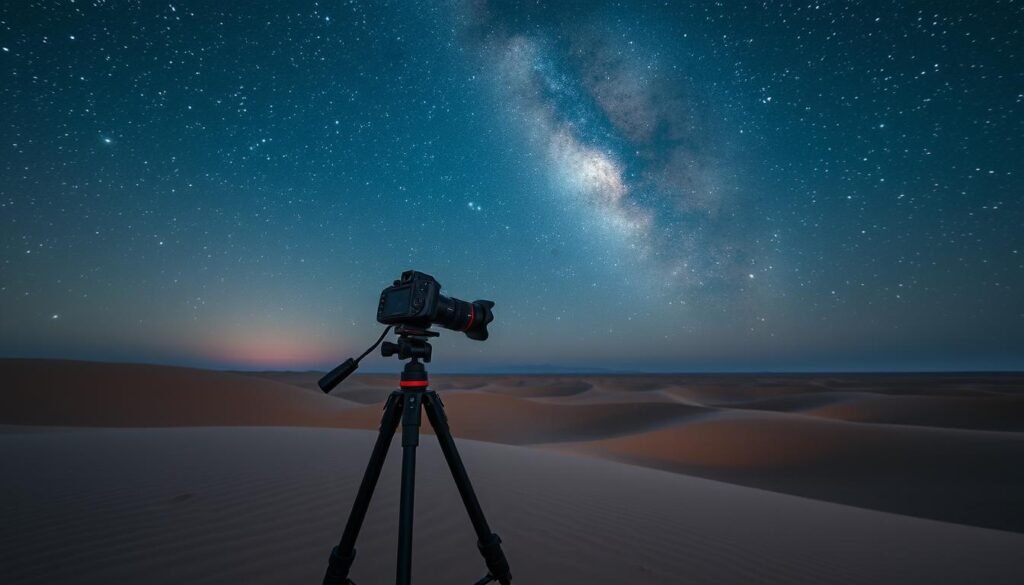
Desert Safety and Preparation Guidelines
Stargazing in the saudi arabian deserts is an amazing experience. But, safety and preparation are key. I’ve learned to plan carefully and know the desert’s challenges.
First, pack the right stuff. You’ll need your telescope or camera, water, snacks, and warm clothes for cold nights. Also, sturdy boots and a light source are crucial for safe travel.
- Always check local weather forecasts and be prepared for sudden changes in temperature or wind conditions.
- Familiarize yourself with the area’s geography and terrain, and consider downloading a GPS app or bringing a map to aid in navigation.
- Be mindful of local wildlife and regulations, and respect the fragile desert ecosystem by staying on designated paths and leaving no trace.
For health and safety, stay hydrated, use sunscreen, and watch for heat exhaustion signs. It’s smart to tell someone your plans and when you’ll be back.
By following these tips, you can enjoy the desert’s stunning stargazing. You’ll stay safe and help protect these special places.
Celestial Objects Visible from Saudi Arabia
Stargazing in Saudi Arabia’s vast deserts is a treat. You’ll see amazing constellations and deep sky objects. The night sky here is truly incredible.
Constellations and Deep Sky Objects
The dark skies of Saudi Arabia are perfect for seeing stars and constellations. You can spot Orion, Ursa Major, and Cassiopeia easily. Look closely for galaxies, nebulae, and star clusters too.
Planetary Viewing Opportunities
The desert in Saudi Arabia is great for watching planets. You might see Saturn’s rings, Jupiter’s colors, or Uranus and Neptune. With the right equipment, these views are even better.
Meteor Showers and Special Events
The desert in Saudi Arabia is perfect for seeing meteor showers and lunar eclipses. Events like the Perseids and Geminids are amazing. Don’t miss out on these by checking the celestial calendar.
FAQ
What are the best times of year for desert stargazing in Saudi Arabia?
The best times for stargazing in Saudi Arabia’s deserts are from October to April. The weather is cool and dry. This makes it perfect for clear views of the stars.
What kind of equipment do I need for desert stargazing in Saudi Arabia?
For great stargazing in Saudi Arabia, bring a top-notch telescope and binoculars. Also, a star chart or app, and a camera for photos. Don’t forget a red-light flashlight, a sturdy tripod, and warm clothes to keep you and your gear safe.
Where are the best stargazing locations in Saudi Arabia’s deserts?
Top spots for stargazing include the Empty Quarter, Al Wadj Bank Dark Sky Reserve, and Al-Ahsa Oasis. These places have little light pollution and beautiful desert views.
How does Saudi Arabia’s dark sky preservation efforts benefit stargazing?
Saudi Arabia’s dark sky efforts are huge for stargazing. The government has cut light pollution and set up dark sky reserves. This makes it easier to see the stars and planets.
What are some of the key celestial objects I can expect to see while stargazing in Saudi Arabia?
In Saudi Arabia’s deserts, you’ll see many stars, constellations, galaxies, and nebulae. You can also spot planets, meteor showers, and other events.
What safety precautions should I take when stargazing in the Saudi Arabian deserts?
Stargazing in Saudi Arabia’s deserts needs careful planning. Bring tools, first aid, water, and food. Know local rules, check the weather, and protect yourself and your gear from the desert.
Don’t forget to share your experience in the comments and follow us on social media at the bottom of the site.
